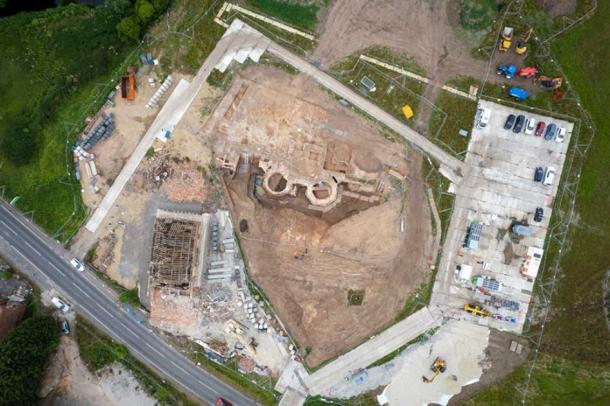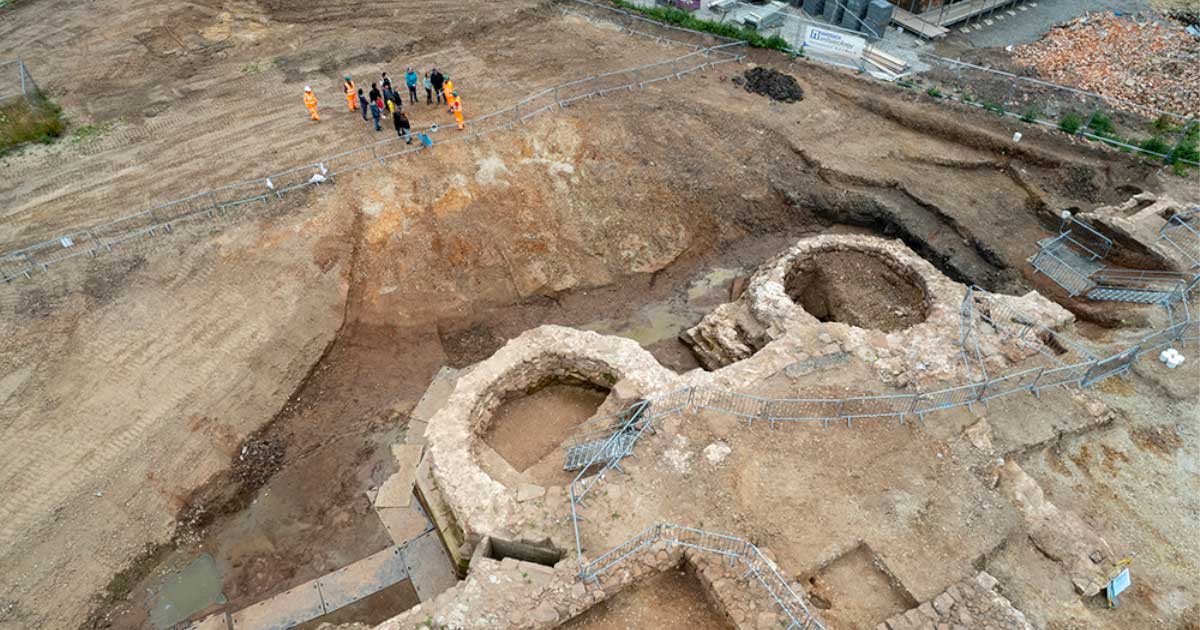Medieval Gatehouse Likely Witnessed First Action of English Civil War
Pock-marked with bullets that likely came from the muskets of Parliamentarian troops bound for the very first battle of the English Civil War, the remains of a medieval gatehouse have been uncovered in England. According to archaeologists digging for the HS2 high-speed rail project, this may be evidence of the action that kicked off the civil war!
The Wessex Archaeology team associated with the HS2 project has recently wrapped up excavations at the historic Coleshill Manor. While the dig has produced many extraordinary treasures, including “one of the most impressive Elizabethan ornamental gardens,” the latest find of the stone bases of two towers from a fortified late medieval gatehouse that archaeologists are treating as possible evidence of the first skirmish of the English Civil War, would have to rank at the very top.
- Medieval Gatehouse Reveals Hundreds of Musket Ball Marks from English Civil War
- Military Historian Discovers Hannibal’s Long-Lost Battlefield
“People always say that you want to find gold in archaeology, but I think for a lot of us finding that tower will always be better than finding gold,” stated Stuart Pierson, who led the dig, in The Guardian. “I think it’s the highlight of our careers finding that, and I don’t think we’re going to find anything like that again.”

Musket ball marks on the medieval gatehouse discovered at Coleshill Manor. (HS2)
Coleshill Manor and Battle for Curdworth Bridge
The English Civil War was a series of engagements and political maneuvering between the Royalist forces of Charles I and Oliver Cromwell’s Parliamentarian forces also known as the Roundheads. It lasted from 1642 to 1651 and resulted in a short-lived victory for the Parliament until the restoration of the monarchy in 1660 under Charles II.
The first recorded battle of the English Civil War, taking place in 1642, was the Battle for Curdworth Bridge which lay only a short distance from Coleshill Manor. Located in the county of Warwickshire, Coleshill is around 105 miles (169 kilometers) northwest of London. The Tudor manor was built at a strategic location next to a bridge over the River Cole.
The manor came into the hands of the Royalist Simon Digby when its previous owner Simon de Montford was hanged, drawn and quartered for treason in 1494. This most recent discovery at the excavated medieval gatehouse seems to indicate that the site witnessed the first action of the English Civil War.

Aerial image of the HS2 excavation of Coleshill Manor and its medieval gatehouse in Warwickshire. (HS2)
The Medieval Gatehouse and Its Likely Connection with the Civil War
Finding the gatehouse came as a real surprise to the archaeologists since the only historical documentation of its existence was a passing mention in 17th-century records. It was a much more impressive structure than this meagre account had led historians to believe.
The gatehouse probably led to a drawbridge over a moat. Medievalist.net reported that it consisted in a large stone building to the back, measuring 10 meters (32 feet) by 10 meters, with two heavily fortified angular towers. It was built of ashlar masonry with uniformly carved stone blocks. It fell into disuse in the 1650s and was torn down in the late 17th century to be replaced by a more modern manor, courtyard and gardens.
The archaeologists of the HS2 team know that the Roundheads would have passed close to the manor on their way to Curdworth Bridge. With its strategic location, seizing command of the manor would undoubtedly have been advantageous for the Roundheads. However, with history recording only the major battles, from here on the reconstruction of events passes into the realm of speculation and conjecture.
Did the Roundheads really stop at Coleshill Manor? And was it the scene of the first skirmish of the civil war? The evidence of the almost 200 impact marks from pistol shots and musket balls on the outer wall of the gatehouse would certainly seem to suggest so. As would the over 40 musket balls recovered from the nearby soil, which would once have been the moat of the manor, the Centre Daily Times explained. However, historians caution that the bullet-peppered walls of the gatehouse may simply be evidence of routine target practice.
- Grisly Discovery of Dozens of Beheaded Skeletons in Britain
- Magnificent Elizabethan-era Garden Unearthed At Coleshill Manor
- Amputation Pit with Sawn-Off Limbs Found at Battle of Waterloo Field Hospital Site
Be that as it may, there is no doubt that it is a pretty special discovery. “The discovery of the medieval gatehouse at Coleshill was quite unexpected - and I was amazed at just how much of the monumental stone building, with its two great octagonal towers, had survived below the ground,” highlighted Professor Alice Roberts, who has presented the find on the BBC series Digging for Britain.
“The front of the gatehouse was pockmarked and had clearly been shot at with muskets - perhaps for target practice - but there’s also an intriguing possibility that we’re looking at evidence of the earliest skirmish of the Civil War,” stressed Roberts.
According to The Guardian, Stuart Pierson explained that not only does the medieval gatehouse discovery have the potential to rewrite the history of start of the English Civil War, but it can also tell us more about how people at large, who may not necessarily have been involved in the war, lived through it.
Top image: HS2 excavation of Coleshill Manor and the excavated medieval gatehouse in Warwickshire. Source: HS2
By Sahir Pandey
References
Addley, E. 21 January 2023. “‘Better than finding gold’: towers’ remains may rewrite history of English civil war” in The Guardian. Available at: https://www.theguardian.com/uk-news/2023/jan/21/coleshill-towers-remains-history-english-civil-war
Medievalist.net. 2023. “Medieval Gatehouse discovered in England” in Medievalist.net. Available at: https://www.medievalists.net/2023/02/medieval-gatehouse-discovered-in-england/
Pflughoeft, A. 2023. “‘Monumental’ structure — riddled with 200 bullet marks — uncovered in UK, photos show” in Centre Daily Times. Available at: https://www.centredaily.com/news/nation-world/world/article271523272.html
Wessex Archaeology. 21 January 2023. “Excavations at Coleshill for HS2 reveal gatehouse may have come under fire during the Civil War” in Wessex Archaeology. Available at: https://www.wessexarch.co.uk/news/excavations-coleshill-hs2-reveal-gatehouse-may-have-come-under-fire-during-civil-war



















